Yamaha Motor Co., Ltd. is a Japanese manufacturer of motorcycles, marine products such as boats and outboard motors, and other motorized products. The company was established in 1955 upon separation from Yamaha Corporation, and is headquartered in Iwata, Shizuoka, Japan. The company conducts development, production and marketing operations through 109 consolidated subsidiaries as of 2012.

The Nissan 240SX is a sports car that was introduced to the North American market by Nissan in 1989 for the following model year. It replaced the outgoing 200SX (S12) model. Most of the 240SX were equipped with the 2.4-liter inline 4 engine. The KA24E had a single overhead cam and KA24DE had dual overhead cams. Two distinct generations of the 240SX, the S13 (1989–1994) the S14 (1994-1998) were produced based on the Nissan S platform.
The Honda XR series is a range of four-stroke off-road motorcycles that were designed in Japan but assembled all over the world.

The Yamaha XV1600A is a cruiser-style motorcycle. It is also called the Yamaha Road Star or in Europe the Yamaha Wild Star. It has been produced from 1999 through model Year 2014 when the Roadstar model line was discontinued. The 1999-2003 models were the same 1602 cc naturally aspirated engines. And in 2004 they changed the displacement to 1,670 cc. With a few design changes in 2004, including new tubeless aluminum wheels, a skinnier drive belt and different engine casing color. The Road Star also has a sleeker, sportier brother called the Yamaha Road Star Warrior that had a fuel-injected 1,700 cc engine and had an all-aluminum chassis. The Road Star remained unchanged until 2008 when electronic fuel injection was introduced to the bike. There were certain variations to the Road Star considering different trim and equipment packages. The Road Star was available with a Silverdo trim package which included studded saddle bags, a back rest, studded driver and passenger seats, and a cruiser-style windscreen. The Silverado package changed names to the "Midnight" package with blacked out engine etc. For a few years, the Road Star was also available in an "S" package, which meant more chrome pieces for the buyer.

The Ferrari 365 GT4 2+2, Ferrari 400 and Ferrari 412 are front-engined V12 2+2 grand tourers made by Italian manufacturer Ferrari between 1972 and 1989. The three cars are closely related, using the same body, chassis and engine evolved over time.

The Honda CX series motorcycles, including the GL500 and GL650 Silver Wing variants, were developed and released by Honda in the late 1970s, with production ending in most markets by the mid 1980s. The design included innovative features and technologies that were uncommon or unused at the time such as liquid cooling, electric-only starting, low-maintenance shaft drive, modular wheels, and dual CV-type carburetors that were tuned for reduced emissions. The electronic ignition system was separate from the rest of the electrical system, but the motorcycle could only be started via the start button.

The Ford Sigma is a small straight-4 automobile engine introduced in 1995 by Ford Motor Company. Its first evolution was sold as the Zetec-S, then Zetec-SE and finally, in later years, renamed Duratec. The last upgrade of the engine is named Duratec Ti-VCT. Conceived for Ford's smaller models, the motor was intended to replace the older HCS and smaller capacity CVH units.
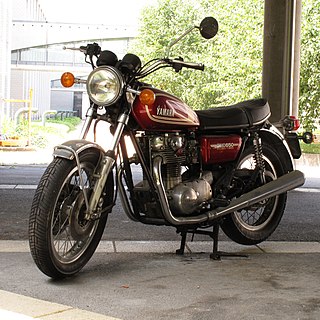
The Yamaha XS650 is a mid-size motorcycle made by Yamaha Motor Company. The standard model was introduced in October 1969,and produced through 1979. The "Special" cruiser model was introduced in 1978 and produced through 1985. The XS650 began with the 1955 Hosk SOHC 500 twin. After about 10 years of producing 500 twin, Hosk engineers designed a 650 cc twin. Later the Hosk company was acquired by Showa Corporation, and in 1960 Yamaha had bought Showa with Hosk's early design of 650 cc twin.

The Suzuki Bandit is a series of standard motorcycles produced by Suzuki since 1989. The Bandit series includes the following models:

The Yamaha SRX is a motorcycle that was manufactured from 1985 to 1997 by the Yamaha Motor Company. Not to be confused with the Yamaha Sidewinder SRX, which is a snowmobile.

The Harley-Davidson Sportster is a line of motorcycles produced continuously since 1957 by Harley-Davidson. Sportster models are designated in Harley-Davidson's product code by beginning with "XL". In 1952, the predecessors to the Sportster, the Model K Sport and Sport Solo motorcycles, were introduced. These models K, KK, KH, and KHK of 1952 to 1956 had a sidevalve engine, whereas the later XL Sportster models use an overhead valve engine. The first Sportster in 1957 had many of the same details of the KH including the frame, fenders, large gas tank and front suspension.

The Kawasaki KZ400/Z400 is a street motorcycle that was produced by Kawasaki between 1974 and 1984. The 398cc displacement of the twin cylinder engine was increased to 443cc for the KZ440/Z440. The later KZ400-J used a 399cc two cylinder engine.
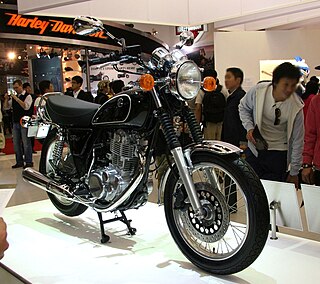
The Yamaha SR400 (1978–2021) and SR500 (1978–1999) are single-cylinder, air-cooled, two-passenger motorcycles manufactured in Japan by Yamaha Motor Company as a street version of the Yamaha XT500, with a standard riding posture and styling resembling the Universal Japanese Motorcycles of the 1970s. The two models differ by their engines: the SR400 engine has a lower displacement, achieved with a different crankshaft and shorter piston stroke and both models feature only kickstarting, i.e., no electric starter.

Yamaha YP 400 Majesty is a scooter made by Yamaha beginning in 2003. The Majesty line includes 150, 250, and 400 cc displacement single-cylinder engine versions available in Europe and Asia. In the US, only the 400 cc model was sold, from 2004 to 2014.
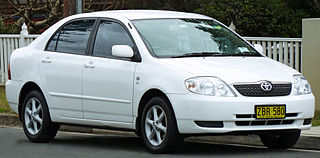
The Toyota Corolla (E120/E130) is the ninth generation of compact cars sold by Toyota under the Corolla nameplate. In Japan, this series arrived to the market in August 2000; however, exports were typically not achieved until 2001 and 2002 depending on the market.
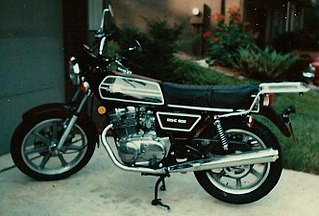
The Yamaha TX500 is a two-cylinder standard motorcycle built by Yamaha and sold in 1973 and 1974. Early models closely resembled the Triumph Bonneville in style. In 1975 the bike was renamed XS500 and then continued to be updated until 1978 when sales ended in the USA. In Europe, the model was available through 1980.

The Honda CB400T is a range of motorcycles built by Honda. In the United Kingdom it was known as the Dream, whereas in the United States it was known as the Hawk. A Honda CB250T version was also available for UK licensing reasons.
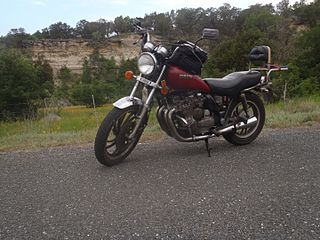
The Yamaha XJ650 Maxim is a mid-size motorcycle by the Yamaha Motor Company introduced in 1980 as the Maxim I and produced through 1983. Yamaha designed the high-performance XJ650 as a brand-new four-cylinder with shaft drive, and built it specifically as a special cruiser. The XJ Maxim was the successor of the XS Special introduced in 1978.

The Yamaha XJ1100 is a Japanese standard motorcycle that was produced for only one year in 1982 in the US and 1983-84 in Canada. This motorcycle employed almost the same motor as its predecessor, the XS 11. The motor was a four-stroke, transverse-mounted four-cylinder engine with dual overhead cams. Its 1101cc engine was making 95 hp at the crank, paired with a 5-speed gearbox and shaft drive.
The Ducati 450 Mark 3 is a 436 cc (26.6 cu in) single cylinder bevel drive SOHC motorcycle produced by the Italian manufacturer Ducati from 1969 to 1974. The 450 was largest displacement version of the OHC single series produced by Ducati and used the 'wide case' engine. A higher performance version, the Ducati 450 Mark 3D, which used desmodromic valves was also available. The 450 was criticised for vibration and lack of performance compared to other models such as the Mach 1.


















